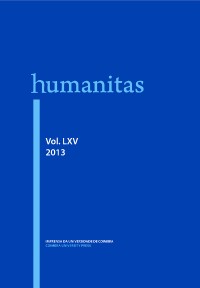Please use this identifier to cite or link to this item:
https://hdl.handle.net/10316.2/27417| DC Field | Value | Language |
|---|---|---|
| dc.contributor.author | Méndez, Sigmund | - |
| dc.contributor.other | Faculdade de Letras da Universidade de Coimbra. Instituto de Estudos Clássicos (ed. lit.) | - |
| dc.date.accessioned | 2013-12-19T16:29:20Z | |
| dc.date.accessioned | 2020-10-02T17:03:14Z | - |
| dc.date.available | 2013-12-19T16:29:20Z | |
| dc.date.available | 2020-10-02T17:03:14Z | - |
| dc.date.issued | 2013 | - |
| dc.identifier.issn | 2183-1718 | - |
| dc.identifier.uri | https://hdl.handle.net/10316.2/27417 | - |
| dc.description.abstract | El De sculptura (1504) de Pomponio Gaurico constituye un notable exponente de la literatura artística neolatina del Renacimiento. El presente artículo se centra en las aportaciones del joven humanista sobre tema de la phantasía aplicadas a la escultura, basadas en diversos conceptos provenientes de fuentes clásicas, en particular, de la esfera de la retórica pero también de la filosofía antigua. Se estudian así términos retóricos como euphantasíotos y enárgeia, o bien kataleptikós, derivado de la filosofía estoica, que constituyen incorporaciones de Gaurico para caracterizar las peculiaridades del proceso creativo del escultor, en sintonía con el intento del autor de estrechar el vínculo entre la cultura escrita y las artes plásticas y la búsqueda renacentista de “elevarlas” al rango de las artes liberales. Asimismo, se revisan algunos de sus apuntes sobre modalidades “imaginarias” del arte antiguo. Todos estos elementos sirven para mostrar la importancia de las reflexiones sobre la phantasía y los procesos interiores y las formas de la invención artística en este período de esplendor práctico y teórico del arte y el hondo influjo del Mundo Antiguo ejercido en ellas. | spa |
| dc.description.abstract | Pomponio Gaurico’s De sculptura (1504) is a noteworthy exemplar of Neo‑Latin artistic literature of the Renaissance. This article focuses on the young humanist’s contributions on the theme of phantasía applied to sculpture and based in several concepts that have arisen from classical fonts, particularly from the rhetorical sphere but from ancient philosophy as well. In this way, it studies rhetorical terms as euphantasíotos and enárgeia or kataleptikós (derived from Stoic philosophy) that constitute Gaurico’s applications for characterizing the creative process of the sculptor, in accordance with the author’s inclination to bridge the gap between literary culture and visual arts, an strategy used as a theoretic and apologetic tool in the Renaissance search for “elevating” them to the level of liberal arts. Likewise, it revises some Gaurico’s notes about expressions of “imaginary” forms in Ancient art. These elements serve to evaluate the importance of the reflections on phantasía and inward processes and forms of artistic invention in this period of practical and theoretical artistic splendour and to recognize the deep influence that the Ancient World’s legacy exerted on them. | eng |
| dc.language.iso | spa | - |
| dc.publisher | Imprensa da Universidade de Coimbra | - |
| dc.subject | Pomponio Gaurico | - |
| dc.subject | De sculptura | - |
| dc.subject | Phantasía | - |
| dc.subject | Kataleptikós | - |
| dc.subject | Enárgeia | - |
| dc.subject | Pomponio Gaurico | eng |
| dc.subject | De sculptura | eng |
| dc.subject | Phantasía | eng |
| dc.subject | Kataleptikós | eng |
| dc.subject | Enárgeia | eng |
| dc.title | Fuentes clásicas sobre la phantasía en el De sculptura de Pomponio Gaurico | por |
| dc.title.alternative | Classical sources on phantasía in Pomponius Gauricus' De sculptura | por |
| dc.type | article | - |
| uc.publication.collection | Humanitas vol. LXV | - |
| uc.publication.firstPage | 141 | - |
| uc.publication.lastPage | 159 | - |
| uc.publication.location | Coimbra | - |
| uc.publication.journalTitle | Humanitas | - |
| uc.publication.volume | 65 | por |
| dc.identifier.doi | 10.14195/2183-1718_65_8 | - |
| uc.publication.section | Artigos | - |
| uc.publication.orderno | 8 | - |
| uc.publication.area | Artes e Humanidades | - |
| uc.publication.manifest | https://dl.uc.pt/json/iiif/10316.2/27417/257883/manifest?manifest=/json/iiif/10316.2/27417/257883/manifest | - |
| uc.publication.thumbnail | https://dl.uc.pt/retrieve/12007232 | - |
| item.fulltext | With Fulltext | - |
| item.grantfulltext | open | - |
| Appears in Collections: | HVMANITAS | |
Files in This Item:
| File | Description | Size | Format | |
|---|---|---|---|---|
| humanitas65_artigo8.pdf | 276 kB | Adobe PDF |  |
Items in DSpace are protected by copyright, with all rights reserved, unless otherwise indicated.
